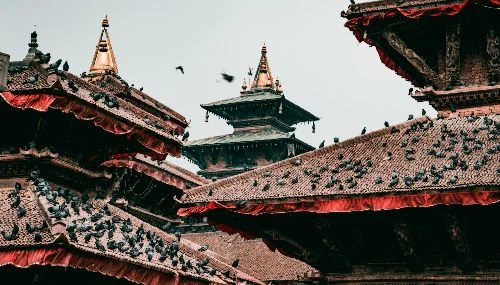High in the windswept wilderness of Upper Mustang, a wall of red rises from the earth like fire frozen in stone.
This is Dhakmar—where crimson cliffs tower above a quiet village, glowing brilliantly under the Himalayan sun. Their vivid color seems almost otherworldly, set against the dusty trails and wide skies of Nepal’s high desert.
For centuries, travelers and locals alike have stood in awe of these natural giants. Not just for their surreal beauty, but for the powerful legends and sacred energy they’re believed to hold.
What gives the cliffs their striking color? Why are they so deeply tied to myth and memory? And what role does this landscape play along one of Nepal’s most remote trekking routes?
This blog explores the Red Cliffs of Dhakmar—from their unique setting and spiritual pull to the stories etched in both geology and legend.
Where Are the Red Cliffs of Dhakmar?

The Red Cliffs rise above Dhakmar, a quiet village perched at an elevation of around 3,800 meters in Nepal’s Upper Mustang region. Surrounded by windswept hills and painted valleys, Dhakmar feels like a place caught between earth and sky.
Geographically, the cliffs sit west of the ancient walled city of Lo Manthang, tucked between the village of Ghami and the well-known Ghar Gumba (Lo Gekar Monastery). Their deep red hues glow brightest in the morning sun, making the area feel both wild and sacred.
If you're trekking through Upper Mustang, Dhakmar is more than just a scenic stop—it’s part of the route. Most trekkers pass through this valley on the way to or from Lo Manthang, following trails that twist past ancient chortens, rugged slopes, and high-altitude passes.
Whether you’re on the classic Upper Mustang Circuit or weaving your own path through Mustang’s cultural heartland, the red cliffs are impossible to miss. They’re unforgettable once seen.
What Makes Them Red?
The cliffs of Dhakmar aren’t painted by hand, but by nature, over millions of years.
Their deep red color comes from iron oxide minerals like hematite, goethite, and limonite, all found in the sedimentary rock that makes up this landscape. When iron-rich rocks are exposed to air and weather, they rust—just like metal—turning brilliant shades of red and orange.
But color isn’t the only story here. These cliffs were shaped by powerful natural forces. Tectonic uplift pushed ancient seabeds high into the sky. Then, wind and the dry Himalayan air slowly carved and sculpted the rock, revealing the colorful layers you see today.
Look closely, and you’ll spot more than just red. There are streaks of brown, yellow, grey, and even white—all stacked like pages in a giant stone book. Each layer marks a chapter in Earth’s story, from ancient oceans to shifting mountains.
That’s what makes Dhakmar a special destination in your Upper Mustang Trek or Upper Mustang Jeep Tour. These cliffs aren’t just beautiful—they’re a geological time capsule. Stand before them, and you’re looking at millions of years written in color, shape, and silence.
The Legend: Demon Blood and Guru Rinpoche
Long before Dhakmar became part of trekking routes and travel guides, it was the setting for a powerful legend. One that still echoes through the red cliffs today.
According to local lore, a fierce demoness (Balmo) once haunted this land, spreading chaos and blocking the spread of Buddhism in the region. Guru Rinpoche (Padmasambhava), the great Buddhist tantric master, journeyed to Upper Mustang to stop it. After a fierce battle, he struck the demoness down, and its blood spilled across the cliffs, turning them deep red.
That’s why the name “Dhakmar” means ‘red blood’ in Tibetan. This story isn’t just told in Dhakmar. It’s woven into the nearby sacred sites, too. At Ghar Gumba, one of the oldest Tibetan Buddhist monasteries in Nepal—people believe Guru Rinpoche left spiritual imprints after his victory. The Mani wall in nearby Ghami, one of the longest in Nepal, is also said to be tied to the same legend, holding prayers and blessings that helped seal the demon’s power forever.
The caves around these cliffs carry their own spiritual weight. Long ago, they were used by followers of the ancient Bon tradition, and later by Buddhist monks seeking silence, reflection, and retreat.
Today, the cliffs of Dhakmar aren’t just natural wonders—they’re sacred ground. Every red streak is more than geology—it’s part of a story passed down through generations, blending myth, faith, and the power of place.
Dhakmar Village: Life Beneath the Cliffs

Nestled quietly beneath the towering red cliffs, Dhakmar village is home to the resilient Loba community, a group deeply rooted in the traditions of Upper Mustang. Life here moves at a gentle pace, shaped by centuries of Tibetan Buddhist culture and close ties to the land.
At the heart of the village stands the ancient Dhakmar Gompa, a monastery that has long served as a spiritual center for locals. Monks keep alive rituals and prayers that connect the present to a rich past, filling the air with the calm energy of devotion and reflection.
Cultural practices in Dhakmar revolve around Tibetan Buddhism, with festivals, prayer wheels, and sacred sites scattered throughout the area. Visitors may notice the quiet reverence in daily life, a peaceful rhythm that feels worlds apart from busier trekking hubs.
For travelers seeking a tranquil, less-touristy alternative to Lo Manthang, Dhakmar offers a rare glimpse into authentic Mustang life. Here, beneath the red cliffs, the spirit of tradition thrives quietly, waiting to be discovered.
Why Visit?
Dhakmar isn’t just another stop on the trail—it’s a place that speaks to different kinds of travelers in different ways. For trekkers, it’s a peaceful pause in the high Himalayas. The cliffs blaze with color, the village hums with quiet tradition, and every step feels meaningful.
For photographers, Dhakmar is a dream. With its bold red cliffs standing tall against soft skies, the morning light casts shadows that turn rock into artwork. Meanwhile, for spiritual travelers, this is sacred ground. Here, legends whisper through the wind, and the silence under the cliffs invites reflection and stillness.
And for the curious? Dhakmar is where science and story come together. Layers of rock tell a tale as old as the mountains, while local myths bring it all to life in ways no textbook ever could. No matter your reason, Dhakmar stays with you. Not just for what you see, but for how it makes you feel.
When to Visit
Timing matters in a place like Dhakmar—especially when the cliffs are the main event.
To catch them at their best, aim for early morning or late afternoon, when the sun hits just right. That’s when the reds glow deepest, and the shadows bring every ridge and wrinkle to life. It’s not just a view—it’s a moment.
As for the seasons, spring (March to May) and autumn (September to November) are ideal. These months bring clear skies, dry trails, and comfortable temperatures—perfect for trekking and photography.
On the other hand, try to avoid the heavy monsoon season. From June to August, the region can get slippery, and cloud cover may hide the cliffs. But with the right timing, Dhakmar shows you its best side—bold, bright, and unforgettable.
Practical Travel Tips
Permits Required: Dhakmar lies within Upper Mustang, a restricted region. You’ll need a Restricted Area Permit (RAP), which costs $500 for the first 10 days and $50 for each additional day. You must also travel with a licensed guide through a registered trekking agency—solo trekking isn’t allowed here.
Dress for the Climate: The weather in Dhakmar is dry, windy, and often chilly, even during sunny days. Bring windproof outer layers, a warm fleece, sun protection, and sturdy trekking shoes. The air is thin and exposed, so layering is key for comfort.
Trekking Routes: Dhakmar is usually visited as part of the Upper Mustang trek, often between Ghami and Lo Manthang. You’ll likely pass through it on day 6 or 7 of the standard circuit. The trail can be dusty, steep in places, and windy, but the views are absolutely worth the effort.
Respect the Culture: This is a deeply spiritual region. Be mindful near monasteries, mani walls, and prayer flags—walk clockwise, don’t touch sacred objects, and always ask before taking photos of people. Quiet respect speaks volumes here.
Final Reflections
Dhakmar isn’t just a place you visit; it’s a place where meaning lives in every layer. Those towering red cliffs don’t just rise from the land—they rise from legend, shaped by time, wind, and belief. Layers of rock tell a geological tale millions of years old, while whispers of Guru Rinpoche and sacred myths add a timeless spiritual weight.
Stand beneath the cliffs and feel the stillness. Let the color, silence, and sacred energy settle into your memory. In Dhakmar, nature and legend come together—bold, beautiful, and unforgettable. Long after the trail fades behind you, the story of this place stays with you.


.webp)

